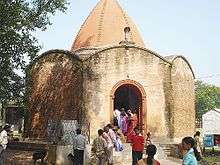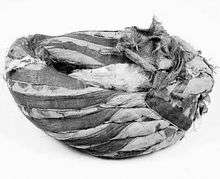Maharaja Nandakumar
Maharaja Nandakumar, also called Nuncomar (1705? - died 5 August 1775), was a collector of taxes, a dewan, for various areas in what is now West Bengal. Nanda Kumar was born at Bhadrapur, which is now in Birbhum. He was India's first victim of hanging under British rule. He was appointed by the East India Company to be the collector of taxes for Burdwan, Nadia and Hoogly in 1764, following the removal of Warren Hastings from the post.[1]
In 1773, when Warren Hastings was re-instated as governor-general of Bengal, Nandakumar brought accusations of Warren Hastings accepting bribes that were entertained by Sir Philip Francis and the other members of the Supreme Council of Bengal. However, Warren Hastings could overrule the Council's charges. Thereafter, in 1775 Warren Hastings brought charges of document forgery against the Maharaja. The Maharaja was tried under Elijah Impey, India's first Chief Justice, and friend of Warren Hastings, was found guilty, and hanged in Kolkata on 5 August 1775.
Later Hastings, along with Sir Elijah Impey, the chief justice, was impeached by the British Parliament. They were accused by Burke (and later by Macaulay) of committing judicial murder.
Early life
Nandkumar was born in a Brahmin family. He held posts under Nawab of Murshidabad. After the Battle of Plassey, he was recommended to Robert Clive for appointment as their agent to collect revenues of Burdwan, Nadia and Hooghly.[2] The title "Maharaja" was conferred on Nandakumar by Shah Alam II in 1764.[1] He was appointed Collector of Burdwan, Nadia, and Hugli by the East India Company in 1764, in place of Warren Hastings. He learnt Vaishnavism from Radhamohana Thakura.[1]
Charges against Hastings
Maharaja Nandakumar accused Hastings of bribing him with more than one-third of a million rupees and claimed that he had proof against Hastings in the form of a letter.[3]
Hanging
Warren Hastings was then with the East India Company and happened to be a school friend of Sir Elijah Impey. Some historians are of the opinion that Maharaja Nandakumar was falsely charged with forgery and Sir Elijah Impey, the first Chief Justice of Supreme Court in Calcutta, gave judgement to hang Nandakumar.[4] Nandakumar's hanging was called a judicial murder by certain historians.[4] Macaulay also accused both men of conspiring to commit a judicial murder.[4] Maharaja Nandakumar was hanged at Calcutta, near present-day Vidyasagar Setu, during Warren Hastings' rule on 5 August 1775.[5] In those days the punishment for forgery was hanging by the Forgery Act, 1728 passed by the British Parliament in England (United Kingdom), but the law was construed for the people committing forgery in England due to the then prevailing conditions in England and there was no provision in the law that it is applicable in India too.[6][7]
Aftermath
Maharaja Nandakumar was a reasonably respectable person, and his hanging created a local panic that resulted in a Bengali exodus from Calcutta to places like Benaras etc.[4]
Books
- Sir James Stephen, The Story of Nuncomar (2 vols., 1885)
- H Beveridge, The Trial of Nanda Kumar (Calcutta, 1886).
Legacy
- A school in his honor, Bhadrapur Maharaja Nanda Kumar High School, was established on his birthplace at Bhadrapur village on Birbhum District.
- A temple was established by him on Akalipur Village near Bhadrapur village. The temple was built for Hindu deity Ma Kaali.This is a very popular temple and thousands of visitors came by. It is situated near the banks of the Brahmani River.
- A college in his honor, Maharaja Nandakumar Vidyalaya, was established in purba medinipur in 2007, and the college is affiliated with Vidyasagar University.[8]
- A road in Baranagar, Kolkata is named Maharaja Nandakumar Road.[9]
- Nandakumar is also the name of a locality in the West Bengal district of East Midnapur.[10]
- Nandakumar railway station was established in Tamluk-Digha branch line of Kharagpur railway division.


External links
- The story of Nuncomar and the impeachment of Sir Elijah Impey Cornell University Library Historical Monographs Collection. {Reprinted by} Cornell University Library Digital Collections

- Charges against Sir Elijah Impey
References
- "The Kunjaghata Raj family". Murshibad.net. Retrieved 10 June 2013.
- "Archived copy". Archived from the original on 2019-02-06. Retrieved 2018-11-18.CS1 maint: archived copy as title (link)
- Barbara Harlow, Edited by Mia Carter (2003). From the East India Company to the Suez Canal. Durham, NC [u.a.]: Duke Univ. Press. p. 132. ISBN 9780822331643.CS1 maint: extra text: authors list (link)
- Bhattacharya, Asim (2010). Portrait of a Vancouver Cabbie. USA: Xlibris Corporation. p. 141. ISBN 9781456836078.
- Mandal, Sanjay (9 November 2005). "History that hangs fire - Nandakumar neglect". The Telegraph (Calcutta). Retrieved 10 June 2013.
- The History of Court by Prof. Pithawala
- Lion Feuchtwanger und Bertolt Brecht, Lion Feuchtwanger (1927). Kalkutta, 4. Mai: drei Akte Kolonialgeschichte. Dr.PLISCHKA Hans Peter. p. 12.
- "Affiliated Colleges". Vidyasagar University. Archived from the original on 25 February 2012. Retrieved 12 June 2013.
- Your local guide. "INDRANI DUTTA KALA NIKETAN IN MAHARAJA NANDAKUMAR ROAD". Bharat Desi. Retrieved 12 June 2013.
- "Floods result in epidemic threat". The Statesman. 20 October 2013. Archived from the original on 23 October 2013. Retrieved 22 October 2013.